Chrysler 2014 Annual Report Download - page 255
Download and view the complete annual report
Please find page 255 of the 2014 Chrysler annual report below. You can navigate through the pages in the report by either clicking on the pages listed below, or by using the keyword search tool below to find specific information within the annual report.-
 1
1 -
 2
2 -
 3
3 -
 4
4 -
 5
5 -
 6
6 -
 7
7 -
 8
8 -
 9
9 -
 10
10 -
 11
11 -
 12
12 -
 13
13 -
 14
14 -
 15
15 -
 16
16 -
 17
17 -
 18
18 -
 19
19 -
 20
20 -
 21
21 -
 22
22 -
 23
23 -
 24
24 -
 25
25 -
 26
26 -
 27
27 -
 28
28 -
 29
29 -
 30
30 -
 31
31 -
 32
32 -
 33
33 -
 34
34 -
 35
35 -
 36
36 -
 37
37 -
 38
38 -
 39
39 -
 40
40 -
 41
41 -
 42
42 -
 43
43 -
 44
44 -
 45
45 -
 46
46 -
 47
47 -
 48
48 -
 49
49 -
 50
50 -
 51
51 -
 52
52 -
 53
53 -
 54
54 -
 55
55 -
 56
56 -
 57
57 -
 58
58 -
 59
59 -
 60
60 -
 61
61 -
 62
62 -
 63
63 -
 64
64 -
 65
65 -
 66
66 -
 67
67 -
 68
68 -
 69
69 -
 70
70 -
 71
71 -
 72
72 -
 73
73 -
 74
74 -
 75
75 -
 76
76 -
 77
77 -
 78
78 -
 79
79 -
 80
80 -
 81
81 -
 82
82 -
 83
83 -
 84
84 -
 85
85 -
 86
86 -
 87
87 -
 88
88 -
 89
89 -
 90
90 -
 91
91 -
 92
92 -
 93
93 -
 94
94 -
 95
95 -
 96
96 -
 97
97 -
 98
98 -
 99
99 -
 100
100 -
 101
101 -
 102
102 -
 103
103 -
 104
104 -
 105
105 -
 106
106 -
 107
107 -
 108
108 -
 109
109 -
 110
110 -
 111
111 -
 112
112 -
 113
113 -
 114
114 -
 115
115 -
 116
116 -
 117
117 -
 118
118 -
 119
119 -
 120
120 -
 121
121 -
 122
122 -
 123
123 -
 124
124 -
 125
125 -
 126
126 -
 127
127 -
 128
128 -
 129
129 -
 130
130 -
 131
131 -
 132
132 -
 133
133 -
 134
134 -
 135
135 -
 136
136 -
 137
137 -
 138
138 -
 139
139 -
 140
140 -
 141
141 -
 142
142 -
 143
143 -
 144
144 -
 145
145 -
 146
146 -
 147
147 -
 148
148 -
 149
149 -
 150
150 -
 151
151 -
 152
152 -
 153
153 -
 154
154 -
 155
155 -
 156
156 -
 157
157 -
 158
158 -
 159
159 -
 160
160 -
 161
161 -
 162
162 -
 163
163 -
 164
164 -
 165
165 -
 166
166 -
 167
167 -
 168
168 -
 169
169 -
 170
170 -
 171
171 -
 172
172 -
 173
173 -
 174
174 -
 175
175 -
 176
176 -
 177
177 -
 178
178 -
 179
179 -
 180
180 -
 181
181 -
 182
182 -
 183
183 -
 184
184 -
 185
185 -
 186
186 -
 187
187 -
 188
188 -
 189
189 -
 190
190 -
 191
191 -
 192
192 -
 193
193 -
 194
194 -
 195
195 -
 196
196 -
 197
197 -
 198
198 -
 199
199 -
 200
200 -
 201
201 -
 202
202 -
 203
203 -
 204
204 -
 205
205 -
 206
206 -
 207
207 -
 208
208 -
 209
209 -
 210
210 -
 211
211 -
 212
212 -
 213
213 -
 214
214 -
 215
215 -
 216
216 -
 217
217 -
 218
218 -
 219
219 -
 220
220 -
 221
221 -
 222
222 -
 223
223 -
 224
224 -
 225
225 -
 226
226 -
 227
227 -
 228
228 -
 229
229 -
 230
230 -
 231
231 -
 232
232 -
 233
233 -
 234
234 -
 235
235 -
 236
236 -
 237
237 -
 238
238 -
 239
239 -
 240
240 -
 241
241 -
 242
242 -
 243
243 -
 244
244 -
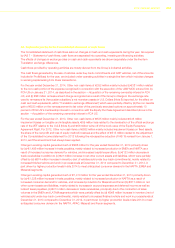 245
245 -
 246
246 -
 247
247 -
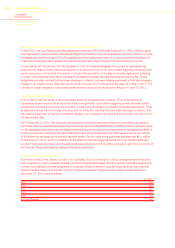 248
248 -
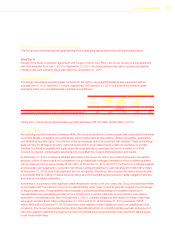 249
249 -
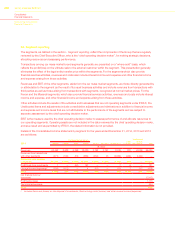 250
250 -
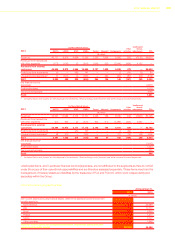 251
251 -
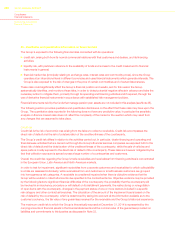 252
252 -
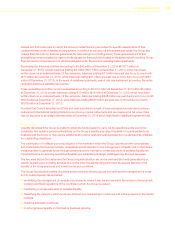 253
253 -
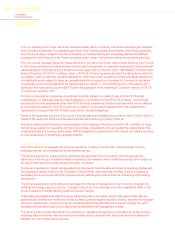 254
254 -
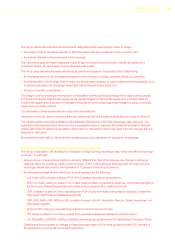 255
255 -
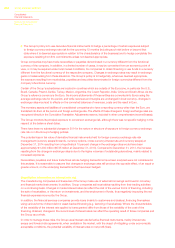 256
256 -
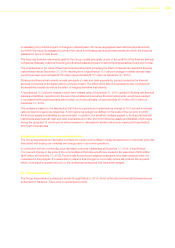 257
257 -
 258
258 -
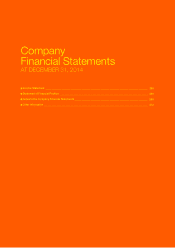 259
259 -
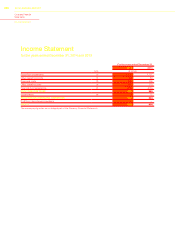 260
260 -
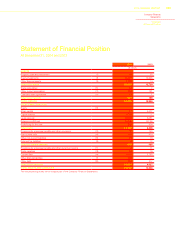 261
261 -
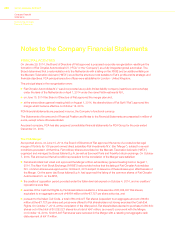 262
262 -
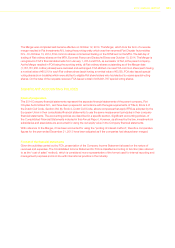 263
263 -
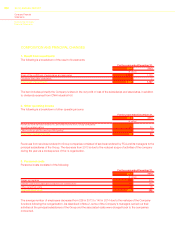 264
264 -
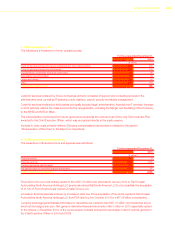 265
265 -
 266
266 -
 267
267 -
 268
268 -
 269
269 -
 270
270 -
 271
271 -
 272
272 -
 273
273 -
 274
274 -
 275
275 -
 276
276 -
 277
277 -
 278
278 -
 279
279 -
 280
280 -
 281
281 -
 282
282 -
 283
283 -
 284
284 -
 285
285 -
 286
286 -
 287
287 -
 288
288 -
 289
289 -
 290
290 -
 291
291 -
 292
292 -
 293
293 -
 294
294 -
 295
295 -
 296
296 -
 297
297 -
 298
298 -
 299
299 -
 300
300 -
 301
301 -
 302
302 -
 303
303
 |
 |

2014 | ANNUAL REPORT 253
The Group utilizes derivative financial instruments designated as fair value hedges mainly to hedge:
the foreign currency exchange rate risk on financial instruments denominated in foreign currency; and
the interest rate risk on fixed rate loans and borrowings.
The instruments used for these hedges are mainly foreign currency forward contracts, interest rate swaps and
combined interest rate and foreign currency financial instruments.
The Group uses derivative financial instruments as cash flow hedges for the purpose of pre-determining:
the exchange rate at which forecasted transactions denominated in foreign currencies will be accounted for;
the interest paid on borrowings, both to match the fixed interest received on loans (customer financing activity), and
to achieve a targeted mix of floating versus fixed rate funding structured loans; and
the price of certain commodities.
The foreign currency exchange rate exposure on forecasted commercial flows is hedged by foreign currency swaps
and forward contracts. Interest rate exposures are usually hedged by interest rate swaps and, in limited cases, by
forward rate agreements. Exposure to changes in the price of commodities is generally hedged by using commodity
swaps and commodity options.
Counterparties to these agreements are major financial institutions.
Information on the fair value of derivative financial instruments held at the balance sheet date is provided in Note 20.
The following section provides qualitative and quantitative disclosures on the effect that these risks may have. The
quantitative data reported below does not have any predictive value, in particular the sensitivity analysis on financial
market risks does not reflect the complexity of the market or the reaction which may result from any changes that are
assumed to take place.
Financial instruments held by the funds that manage pension plan assets are not included in this analysis.
Quantitative information on foreign currency exchange rate risk
The Group is exposed to risk resulting from changes in foreign currency exchange rates, which can affect its earnings
and equity. In particular:
where a Group company incurs costs in a currency different from that of its revenues, any change in exchange
rates can affect the operating results of that company. In 2014, the total trade flows exposed to foreign currency
exchange rate risk amounted to the equivalent of 15 percent of the Group’s turnover.
the principal exchange rates to which the Group is exposed are the following:
U.S. Dollar/CAD, primarily relating to FCA US’s Canadian manufacturing operations;
EUR/U.S. Dollar, relating to sales in U.S. Dollars made by Italian companies (in particular, companies belonging to
the Ferrari and Maserati segments) and to sales and purchases in Euro made by FCA US;
CNY, in relation to sales in China originating from FCA US and from Italian companies (in particular, companies
belonging to the Ferrari and Maserati segments);
GBP, AUD, MXN, CHF, ARS and VEF in relation to sales in the UK, Australian, Mexican, Swiss, Argentinean and
Venezuelan markets;
PLN and TRY, relating to manufacturing costs incurred in Poland and Turkey;
JPY mainly in relation to purchase of parts from Japanese suppliers and sales of vehicles in Japan;
U.S. Dollar/BRL, EUR/BRL, relating to Brazilian manufacturing operations and the related import and export flows.
Overall trade flows exposed to changes in these exchange rates in 2014 made up approximately 90.0 percent of
the exposure to currency risk from trade transactions.
